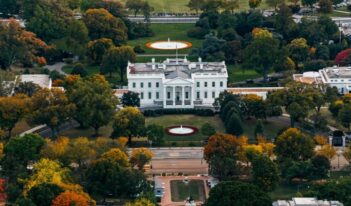
Our system of checks and balances moves slowly—but hopefully effectively.
I offer sincere thanks to each of the six reviewers who exerted the effort to read and critique Regulatory Reform from Nixon to Biden. I do not feel compelled to offer any detailed responses, as their observations are insightful. In this reply, I offer only a few comments of potential interest for future thinking and research, especially given the turbulence at the outset of the second Trump Administration. The book covers only the first three years of President Joseph R. Biden’s term, and when I wrote the book, the outcome of the November 2024 presidential election was an open question.
In their superb reviews, Stuart Shapiro and Edward Balleisen wonder whether the second Trump Administration represents a complete departure from the relative continuity of the 10 previous presidential Administrations. I do not know for sure. The book, however, offers some relevant insight.
The Reagan “revolution” began in 1981 with small-government enthusiasms, such as proposals to abolish the U.S. Departments of Energy and Education and even the Consumer Product Safety Commission. The budgets of social regulatory agencies were slashed while the appointees to those agencies were typically anti-regulation in their outlook. There was a determined effort to repeal the requirement that automakers equip cars with airbags—one of President Reagan’s campaign pledges to the troubled automotive sector—and there was even talk of repealing or scaling back the Clean Air Act and Clean Water Act.
Doesn’t the start of President Donald J. Trump’s second Administration sound a bit familiar to the start of President Ronald Reagan’s first? Yes, President Reagan’s tone was nuanced while President Trump’s tone is combative, and I recall nothing like the Department of Government Efficiency (DOGE) under President Reagan. There are, however, many similarities. So what did the Reagan Administration accomplish?
As I explain in Chapter 5 of my book, much of this small-government agenda ended prior to President Reagan’s reelection in 1984 and the start of his second term. Prior to his reelection, President Reagan championed new legislation that forced states to adopt a minimum legal drinking age of 21. Is that small government at work? President Reagan’s “regulatory relief” in 1985 came to include more progressive measures, such as accelerated U.S. Food and Drug Administration approval of experimental therapies for AIDS patients and more use of alternative, “clean” fuels under the Clean Air Act. President Reagan’s second round of leaders at the social regulatory agencies were more moderate in their outlook. Budget cuts at these agencies were largely restored, although there was a harmful loss of experienced human capital at the U.S. Environmental Protection Agency (EPA), among others. The U.S. Supreme Court unanimously held in 1983 that the repeal of the airbag mandate needed to be reconsidered given the lifesaving benefits of the technology. And President Reagan’s second term was full of ambitious new regulatory programs including the phase-out of chemicals that deplete the ozone layer and new legislation on the management of hazardous wastes. The book argues that President Reagan’s lasting impact on regulatory reform was not small-government conservatism; it was presidential supervision of the administrative state, or at least of the cabinet agencies and EPA.
My point in drawing the analogy of President Trump’s second Administration to President Reagan’s first term is that the Trump Administration—now in its fourth month—has not yet experienced the full force of the checks and balances in the U.S. political system. Time will tell.
Judge Douglas H. Ginsburg offers a deeper rationale than I offered for President Reagan’s 1985 executive order requiring agencies to periodically disclose to the Office of Information and Regulatory Affairs (OIRA) their future regulatory agendas. This reform allowed agency leaders, OIRA, and the President to discourage bad rulemakings from the outset, rather than trying to revise or block them during a rulemaking. Disclosures of an agency’s future agenda are certainly of some value, but—insofar as the agency has not yet performed a benefit-cost analysis of rulemaking alternatives—how would agency leaders, OIRA, or the President know whether to discourage or encourage the rulemaking? As the regulatory-agenda requirement evolved under subsequent Presidents, one of its biggest impacts has been early warning for stakeholders, the U.S. Congress, and the public as to where an agency might be headed. That seems useful. There is, however, a sobering experience in the Obama years that I review in Chapter 7. As President Barack Obama’s 2012 reelection bid began, the President’s team was sensitive about the allegation that President Obama was overregulating during the fragile economic recovery from the Great Recession of 2007–2009. The result? President Obama’s team decided against publishing any regulatory agenda in 2012 to avoid giving ammunition to political opponents. For the regulatory-agenda requirement to have maximum public value, it should be included in the next refinement of the Administrative Procedure Act. Executive orders are too easy for Presidents to ignore when they are inconvenient.
Rena Steinzor is concerned that the book is too critical of the Biden Administration and too light on climate policy. I agree that we should not rush to judgment on the Biden era, as it is still not apparent how many of President Joseph R. Biden’s policies will survive the courts and the Trump Administration, or what the impacts of the surviving policies will be. For readers interested in climate policy, the book offers extensive treatment of that issue in the chapters on Presidents George H.W. Bush, Bill Clinton, George W. Bush, Barack Obama, Donald Trump, and Joe Biden.
Gary Bass and Rick Melberth yearn for better solutions than I offer in the final chapter. I am certainly open to new ideas. One of the reasons I focus on refinement of the “benefit-cost state”—rather than proposing an entirely new framework—is that benefit-cost thinking has proven its value. It has fostered helpful deregulation of the transportation and telecommunications sectors; protected good regulations, such as airbag requirements, from hasty repeal; and helped shape constructive new rulemakings, such as the accelerated phase-out of lead in gasoline. Due to the diffusion of law and economics in law school curricula, we have an increasing number of legislators and judges who are familiar with benefit-cost analysis as a tool to help think through complex issues. We should build on this experience while we improve the tool rather sweep it away and start anew.
Jennifer Nou puts her finger on some complicating developments in judicial thinking that trouble me and are worthy of consideration by both constitutional theorists and practitioners. There is much effort at the Supreme Court to prevent the President, or “the bureaucracy,” from usurping the lawmaking power of Congress. When there are “major questions” and vague delegations of authority to the executive branch, the judiciary apparently is compelled by the design of the U.S. Constitution to force those issues back to Congress for proper resolution.
Is it possible, however, that the framers did not foresee the development of the modern presidency or the persistent dysfunction of the current-day Congress? My beloved colleague Lee Hamilton of Indiana University, who served with distinction in Congress for almost 40 years, argues that the proper solution is to reform Congress so that the institution can play the dominant role in domestic affairs that the framers envisioned. Good steps in that direction would include establishing a new congressional Office of Regulatory Analysis to complement the Congressional Budget Office and a revived Office of Technology Assessment. Hamilton’s stance is certainly a defensible position, but I worry that Congress will not reform itself. I am inclined to a more pragmatic view that the Roberts Court does occasionally espouse—that the President, the only elected figure in the United States with a national constituency, should have a strong hand in regulatory policymaking when Congress is not capable of resolving a pressing issue. There is nothing, for example, in Loper Bright Enterprises v. Raimondo—last year’s decision in which the Court ruled that courts should no longer defer to agency interpretations of unclear statutes—that is inconsistent with presidential implementation of the benefit-cost state.
What happens when an ill-advised President goes rogue, making decisions without considering science, benefit-cost analysis, or justice? The United States has had its share of bad Presidents, and we will have more of them. The book shows that our system of checks and balances, though it takes some time for them to operate, is robust.
In closing, I remain exceedingly grateful for the thoughtful engagement of each reviewer and the broader community of scholars working to understand the evolution of regulatory governance. As the nation confronts new challenges, I hope this book serves as a useful foundation for future efforts—across Congress, the executive branch, and the judiciary—to advance a more effective, efficient, just, and accountable regulatory state.
This essay is part of a series, titled “Presidential Legacies of Regulatory Reform.”




